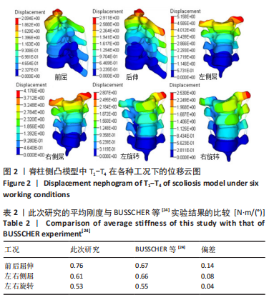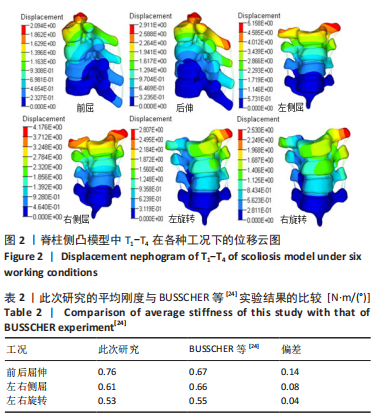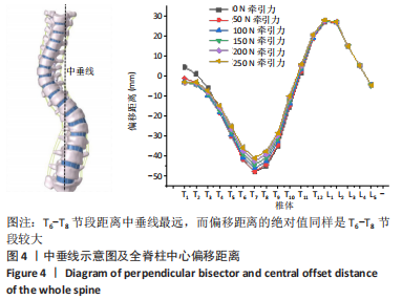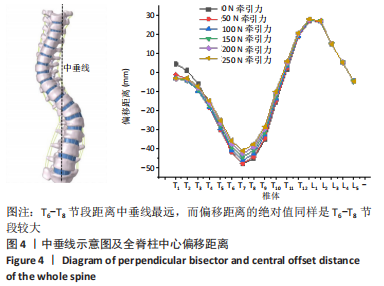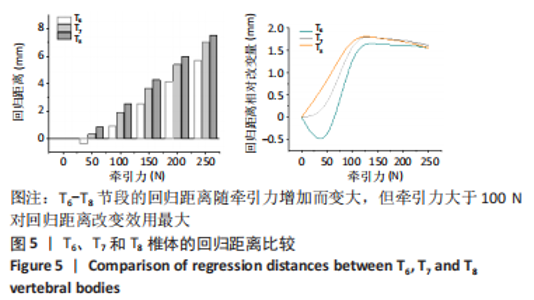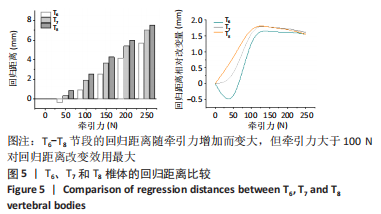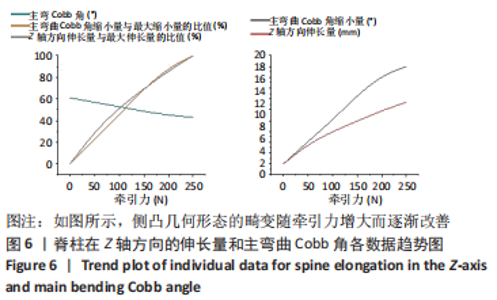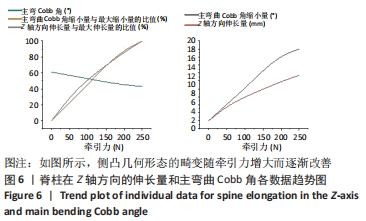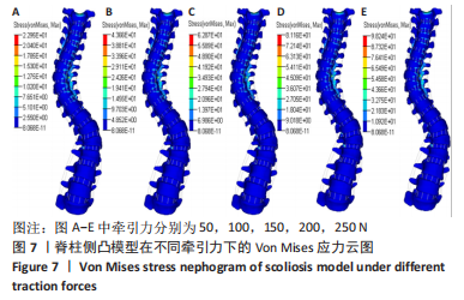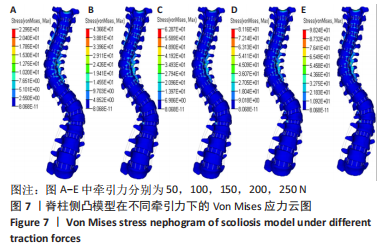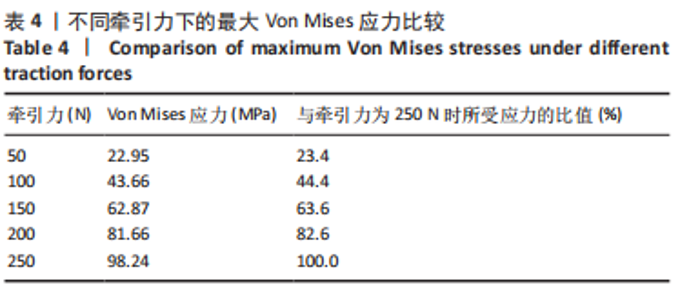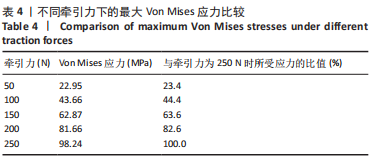Chinese Journal of Tissue Engineering Research ›› 2024, Vol. 28 ›› Issue (18): 2901-2905.doi: 10.12307/2024.072
Previous Articles Next Articles
Biomechanical analysis of optimal Halo gravity traction in treatment of Lenke 3 scoliosis
Fu Rongchang, Yang Xiaozheng, Li Xianzheng
- College of Intelligent Manufacturing Modern Industry, Xinjiang University, Urumqi 830017, Xinjiang Uygur Autonomous Region, China
-
Received:2023-04-08Accepted:2023-06-01Online:2024-06-28Published:2023-08-26 -
Contact:Fu Rongchang, Master, Associate professor, Master’s supervisor, College of Intelligent Manufacturing Modern Industry, Xinjiang University, Urumqi 830017, Xinjiang Uygur Autonomous Region, China -
About author:Fu Rongchang, Master, Associate professor, Master’s supervisor, College of Intelligent Manufacturing Modern Industry, Xinjiang University, Urumqi 830017, Xinjiang Uygur Autonomous Region, China -
Supported by:National Natural Science Foundation of China, No. 32260235 (to FRC)
CLC Number:
Cite this article
Fu Rongchang, Yang Xiaozheng, Li Xianzheng. Biomechanical analysis of optimal Halo gravity traction in treatment of Lenke 3 scoliosis[J]. Chinese Journal of Tissue Engineering Research, 2024, 28(18): 2901-2905.
share this article
Add to citation manager EndNote|Reference Manager|ProCite|BibTeX|RefWorks
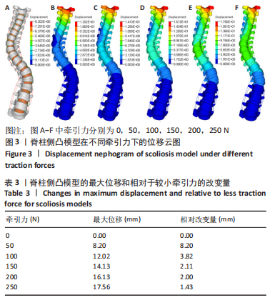
此模型的前屈后伸工况与BUSSCHER等[24]的实验结果的偏差超过了0.10,此偏差可能是由于BUSSCHER的实验选用的是正常人体,而此次研究的T1-T4节段模型本身就存在一定程度畸形造成的。在左右侧屈和左右旋转工况时,模型仿真结果的平均刚度与BUSSCHER等[24]的实验结果具有较好的一致性,因此模型的有效性得到了验证。 2.2 T1-L5位移 随着牵引力的增大,位移较大的区域在逐渐改变,见图3。5种牵引力下T1和T2位移最大;当牵引力达到150 N之后,T1椎体接近正常人水平,T6-T9椎体位移较大,当牵引力达到200 N之后,这种趋势更加明显;对远端次弯曲影响较小。牵引力越大,最大位移越大;但最大位移改变量在减小,尤其从牵引力从200 N增加到250 N时,最大位移的改变量降至1.43 mm,见表3。"
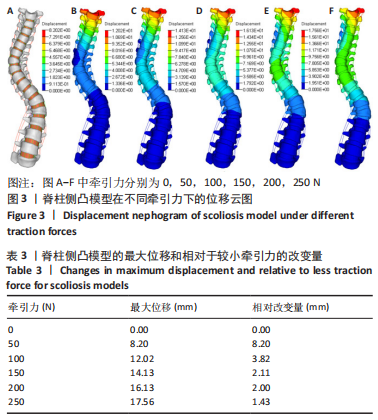
| [1] 刘小丹. 脊柱的简化模型及其在侧弯矫正中的应用[D].上海:上海交通大学,2009. [2] QIAO J, XIAO L, XU L, et al. Skull-femoral traction after posterior release for correction of adult severe scoliosis: efficacy and complications. BMC Musculoskelet Disord. 2018;19(1):277. [3] MEHRPOUR S, SORBI R, REZAEI R, et al. Posterior-only surgery with preoperative skeletal traction for management of severe scoliosis. Arch Orthop Trauma Surg. 2017;137(4):457-463. [4] NEAL KM, SIEGALL E. Strategies for Surgical Management of Large, Stiff Spinal Deformities in Children. J Am Acad Orthop Surg. 2017;25(4):e70-e78. [5] O’DONNELL J, GARCIA S, ALI S, et al. Indications and Efficacy of Halo-Gravity Traction in Pediatric Spinal Deformity: A Critical Analysis Review. JBJS Rev. 2023; 11(3). doi: 10.2106/JBJS.RVW.22.00204. [6] REED LA, MIHAS A, BUTLER R, et al. Halo Gravity Traction for the Correction of Spinal Deformities in the Pediatric Population: A Systematic Review and Meta-Analysis. World Neurosurg. 2022;164:e636-e648. [7] 吴春云.Halo重力牵引联合康复干预对Ⅰ型神经纤维瘤病伴重度脊柱侧凸患者肺功能的影响[J].中国医刊,2020,55(11):1192-1195. [8] 程俊杰,马原,田慧中.一期头盆环牵引二期后路截骨矫正重度脊柱后凸侧后凸的临床效果评价[J].中国矫形外科杂志,2014,22(10):949-951. [9] MEFTAH K, SEDIRA L, AYADI A. A six-node prismatic solid finite element for geometric nonlinear problems in elasticity. Mathematics and Computers in Simulation. 2021;182;143-164. [10] ZHAO X, FAN W, WANG ZH, et al. An explicit finite element approach for simulations of transient meshing contact of gear pairs and the resulting wear. Wear. 2023;523:204802. [11] WANG HZ, YANG P, XIE Q, et al. Crystal plasticity finite element study on the formation of Goss-oriented deformation inhomogeneous regions in electrical steels. Int J Mater Form. 2023. doi: 10.1007/s12289-023-01754-3 [12] NGUYEN AD, NGUYEN VT, KIM YS. Finite element analysis on dynamic behavior of sheet pile quay wall dredged and improved seaside subsoil using cement deep mixing. Int J Geo Eng. 2023;14(1):185. [13] 周晨,邢文华.3D打印技术与有限元分析在脊柱侧凸矫形中的应用优势[J].中国组织工程研究,2021,25(12):1898-1903. [14] 赵龙,王剑,韩正才,等.椎体成形术后残余后凸畸形的有限元分析[J].中国矫形外科杂志,2020,28(22):2082-2086. [15] 邓健全,陈进军,梁洪生,等.仿真分析不同步态下腰椎受力的生物力学变化[J].中国组织工程研究,2019,23(28):4541-4545. [16] 颜文涛,赵改平,方新果,等.人体腰椎L_(4~5)节段有限元建模及分析[J].生物医学工程学杂志,2014,31(3):612-618. [17] TOTORIBE K, CHOSA E, TAJIMA N. A biomechanical study of lumbar fusion based on a three-dimensional nonlinear finite element method. J Spinal Disord Tech. 2004;17(2):147-153. [18] GUAN T, ZHANG Y, ANWAR A, et al. Determination of Three-Dimensional Corrective Force in Adolescent Idiopathic Scoliosis and Biomechanical Finite Element Analysis. Front Bioeng Biotechnol. 2020;8:963. [19] CAO F, FU R, WANG W. Comparison of biomechanical performance of single-level triangular and quadrilateral profile anterior cervical plates. PLoS One. 2021; 16(4):e0250270. [20] 欧华.重度僵硬脊柱侧弯三维有限元模型的建立及PVCR术生物力学分析[D].昆明: 昆明医科大学,2018. [21] 昌怀,刘志军,晏峻峰,等.Lenke 1AN型青少年特发性脊柱侧凸不同置棒顺序矫形的有限元分析[J].中国矫形外科杂志,2019,27(19):1780-1784. [22] 朱海明,丁亮,张东,等.胸腰椎爆裂性骨折短节段伤椎固定三维有限元模型构建及生物力学比较研究[J].中国矫形外科杂志,2015,23(10):917-920. [23] 辛大奇,胡侦明,汉迪,等.Lenke3型成人特发性脊柱侧凸有限元模型的参数修正及有效性验证[J].中国组织工程研究,2017,21(31):4975-4982. [24] BUSSCHER I, VAN DIEËN JH, KINGMA I, et al. Biomechanical characteristics of different regions of the human spine: an in vitro study on multilevel spinal segments. Spine (Phila Pa 1976). 2009;34(26):2858-2864. [25] HWANG CJ, KIM DG, LEE CS, et al. Preoperative Halo Traction for Severe Scoliosis. Spine (Phila Pa 1976). 2020;45(18):E1158-E1165. [26] 温建清,列平,黄春明,等.头盆环牵引治疗重度僵硬性脊柱侧凸病人的护理[J].护理学杂志,2004,19(20):17-18. [27] MARKETOS SG, SKIADAS P. Hippocrates. The father of spine surgery. Spine. 1999;24(13):1381-1387. [28] XU E, GAO R, JIANG H, et al. Combined Halo Gravity Traction and Dual Growing Rod Technique for the Treatment of Early Onset Dystrophic Scoliosis in Neurofibromatosis Type 1. World Neurosurg. 2019:e173-e180. [29] 王东贵,张承旻,张强,等.新型Halo-重力牵引装置的设计及其初步临床应用[J].局解手术学杂志,2019,28(10):829-833. [30] KARIMI MT, EBRAHIMI MH, MOHAMMADI A, et al. Evaluation of the influences of various force magnitudes and configurations on scoliotic curve correction using finite element analysis. Australas Phys Eng Sci Med. 2017;40(1):231-236. [31] PASHA S, AUBIN CE, LABELLE H, et al. The biomechanical effects of spinal fusion on the sacral loading in adolescent idiopathic scoliosis. Clin Biomech (Bristol, Avon). 2015;30(9):981-987. |
| [1] | Li Zhifei, Yang Yin, Chen Hualong, Liang Qinqiu, Zhong Yuanming, Zhang Yisheng. Finite element analysis of the correlation between tilt angle of titanium cage and postoperative subsidence of titanium cage after anterior subtotal cervical corpectomy, decompression and fusion [J]. Chinese Journal of Tissue Engineering Research, 2024, 28(9): 1313-1319. |
| [2] | Ouyang Beiping, Ma Xiangyang, Luo Chunshan, Zou Xiaobao, Lu Tingsheng, Chen Qiling. Three-dimensional finite element analysis of a new horizontal screw-screw crosslink in posterior atlantoaxial internal fixation [J]. Chinese Journal of Tissue Engineering Research, 2024, 28(9): 1320-1324. |
| [3] | Liang Cheng, Zhang Linqi, Wang Guan, Li Wen, Duan Ke, Li Zhong, Lu Xiaobo, Zhuo Naiqiang. Finite element and biomechanical analysis of different implants in repair for unilateral unstable pelvic posterior ring injury [J]. Chinese Journal of Tissue Engineering Research, 2024, 28(9): 1336-1341. |
| [4] | Guo Sutong, Feng Dehong, Guo Yu, Wang Ling, Ding Yujian, Liu Yi, Qian Zhengying, Li Mingyang. Construction and finite element analysis of normal and osteoporotic hip models [J]. Chinese Journal of Tissue Engineering Research, 2024, 28(9): 1342-1346. |
| [5] | Yang Junliang, Lu Tan, Xu Biao, Jiang Yaqiong, Wang Fucheng. Three-dimensional finite element analysis of effects of partial anterior cruciate ligament rupture on knee joint stress [J]. Chinese Journal of Tissue Engineering Research, 2024, 28(9): 1347-1353. |
| [6] | Li Chaojie, Gulati•Maitirouzi, Aierxiding•Abulaiti, Zheng Hui, Tu Hudi. Finite element analysis of medial patellofemoral ligament reconstruction at different flexion angles [J]. Chinese Journal of Tissue Engineering Research, 2024, 28(9): 1359-1364. |
| [7] | Zuo Xinwei, Liu Gang, Bai Huizhong, Xu Lin, Zhao Yi, Ren Jingpei, Hu Chuanyu, Mu Xiaohong. Relationship between lumbar spine development and hip development in children with spastic cerebral palsy [J]. Chinese Journal of Tissue Engineering Research, 2024, 28(8): 1247-1252. |
| [8] | Xiaheida·Yilaerjiang, Nijiati·Tuerxun, Reyila·Kuerban, Baibujiafu·Yelisi, Chen Xin. Three-dimensional finite element analysis of the distribution pattern of stress in bone tissues with different characteristics [J]. Chinese Journal of Tissue Engineering Research, 2024, 28(8): 1277-1282. |
| [9] | Wang Qiang, Li Shiyun, Xiong Ying, Li Tiantian. Biomechanical changes of the cervical spine in internal fixation with different anterior cervical interbody fusion systems [J]. Chinese Journal of Tissue Engineering Research, 2024, 28(6): 821-826. |
| [10] | Wei Yuanbiao, Lin Zhan, Chen Yanmei, Yang Tenghui, Zhao Xiao, Chen Yangsheng, Zhou Yanhui, Yang Minchao, Huang Feiqi. Finite element analysis of effects of sagittal cervical manipulation on intervertebral disc and facet joints [J]. Chinese Journal of Tissue Engineering Research, 2024, 28(6): 827-832. |
| [11] | Zhang Rui, Wang Kun, Shen Zicong, Mao Lu, Wu Xiaotao. Effects of endoscopic foraminoplasty and laminoplasty on biomechanical properties of intervertebral disc and isthmus [J]. Chinese Journal of Tissue Engineering Research, 2024, 28(6): 833-839. |
| [12] | Kang Zhijie, Cao Zhenhua, Xu Yangyang, Zhang Yunfeng, Jin Feng, Su Baoke, Wang Lidong, Tong Ling, Liu Qinghua, Fang Yuan, Sha Lirong, Liang Liang, Li Mengmeng, Du Yifei, Lin Lin, Wang Haiyan, Li Xiaohe, Li Zhijun. Finite element model establishment and stress analysis of lumbar-sacral intervertebral disc in ankylosing spondylitis [J]. Chinese Journal of Tissue Engineering Research, 2024, 28(6): 840-846. |
| [13] | Zhang Min, Peng Jing, Zhang Qiang, Chen Dewang. Mechanical properties of L3/4 laminar decompression and intervertebral fusion in elderly osteoporosis patients analyzed by finite element method [J]. Chinese Journal of Tissue Engineering Research, 2024, 28(6): 847-851. |
| [14] | Wu Maodong, Su Qinglun, Huang Yiming, Shen Longying, Lu Yu, Zhao Qin. Correlation between coronal pressure variation and coronal imbalance in adolescent idiopathic scoliosis patients [J]. Chinese Journal of Tissue Engineering Research, 2024, 28(6): 852-856. |
| [15] | Xue Xiaofeng, Wei Yongkang, Qiao Xiaohong, Du Yuyong, Niu Jianjun, Ren Lixin, Yang Huifeng, Zhang Zhimin, Guo Yuan, Chen Weiyi. Finite element analysis of osteoporosis in proximal femur after cannulated screw fixation for femoral neck fracture [J]. Chinese Journal of Tissue Engineering Research, 2024, 28(6): 862-867. |
| Viewed | ||||||
|
Full text |
|
|||||
|
Abstract |
|
|||||
